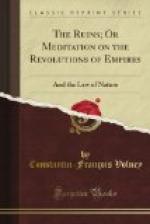These are the sacred volumes of the Hindoos; they are sometimes written Vedams, Pouranams, Chastrans, because the Hindoos, like the Persians, are accustomed to give a nasal sound to the terminations of their words, which we represent by the affixes on and an, and the Portuguese by the affixes om and am. Many of these books have been translated, thanks to the liberal spirit of Mr. Hastings, who has founded at Calcutta a literary society, and a printing press. At the same time, however, that we express our gratitude to this society, we must be permitted to complain of its exclusive spirit; the number of copies printed of each book being such as it is impossible to purchase them even in England; they are wholly in the hands of the East India proprietors. Scarcely even is the Asiatic Miscellany known in Europe; and a man must be very learned in oriental antiquity before he so much as hears of the Jones’s, the Wilkins’s, and the Halhed’s, etc. As to the sacred books of the Hindoos, all that are yet in our hands are the Bhagvat Geeta, the Ezour-Vedam, the Bagavadam, and certain fragments of the Chastres printed at the end of the Bhagvat Geeta. These books are in Indostan what the Old and New Testament are in Christendom, the Koran in Turkey, the Zadder and the Zendavesta among the Parses, etc. When I have taken an extensive survey of their contents, I have sometimes asked myself, what would be the loss to the human race if a new Omar condemned them to the flames; and, unable to discover any mischief that would ensue, I call the imaginary chest that contains them, the box of Pandora.
The Bramins stopping short at these words: “How can we admit your doctrine,” said the legislator, “if you will not make it known? And how did its first authors propagate it, when, being alone possessed of it, their own people were to them profane? Did heaven reveal it to be kept a secret?"*
* The Vedas or Vedams are the sacred volumes of the Hindoos, as the Bibles with us. They are three in number; the Rick Veda, the Yadjour Veda, and the Sama Veda; they are so scarce in India, that the English could with great difficulty find an original one, of which a copy is deposited in the British Museum; they who reckon four Vedas, include among them the Attar Veda, concerning ceremonies, but which is lost. There are besides commentaries named Upanishada, one of which was published by Anquetil du Peron, and entitled Oupnekhat, a curious work. The date of these books is more than twenty-five centuries prior to our era; their contents prove that all the reveries of the Greek metaphysicians come from India and Egypt. Since the year 1788, the learned men of England are working in India a mine of literature totally unknown in Europe, and which proves that the civilization of India ascends to a very remote antiquity. After the Vedas come the Chastras amounting to six. They treat of theology and the Sciences. Afterwards




